AMD Beema/Mullins Architecture & Performance Preview
by Anand Lal Shimpi on April 29, 2014 12:00 AM ESTThe Discovery Tablet
AMD is in a difficult position these days. Traditionally it was the cheaper alternative to Intel, but with Bay Trail Intel made a serious push into segments where OEMs would traditionally use lower cost AMD silicon. In an attempt to be more than a lower cost Intel alternative, AMD is throwing its hat into the form factor reference design race and offering OEMs an example of a full, ideal, high performance implementation of its silicon. One such example is AMD’s Discovery Tablet, an 11.6-inch 1080p Windows 8.1 tablet design that features AMD’s highest end A10 Micro-6700T Mullins silicon. The tablet is a bit larger and heavier than I’d like. If AMD is going to build a reference platform I’d prefer it to be a form factor I’d actually use, which in a tablet is going to be something smaller than 11.6-inches. If you are trying to cover both tablet and 2-in-1 form factors however, the Discovery Tablet makes sense.
I was allowed to spend a few hours benchmarking AMD’s Discovery Tablet. Unfortunately the device wasn’t instrumented for power testing, nor was there enough time to run any battery life tests on it, so the usefulness of these numbers is limited. We already know that AMD’s idle power isn’t as good as smartphone silicon, but for some of these value Windows 8.1 devices it may still be good enough.
Tablet JS/Web Browser Tests
We'll start with our usual set of JavaScript tests. Here we see AMD's A10 Micro-6700T outperform everything on the list. Whether we're talking about Bay Trail or Apple's A7, the 6700T pulls ahead by a decent margin. Once again the big question is how much power is being drawn to deliver this performance. Unlike Intel's Bay Trail preview, AMD didn't have any instrumented Discovery tablets setup for us to monitor power consumption. I suspect AMD's power consumption is competitive, but my guess is it isn't similarly class leading.
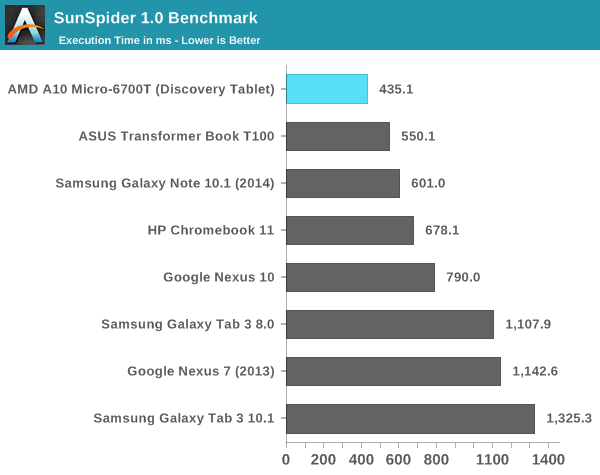
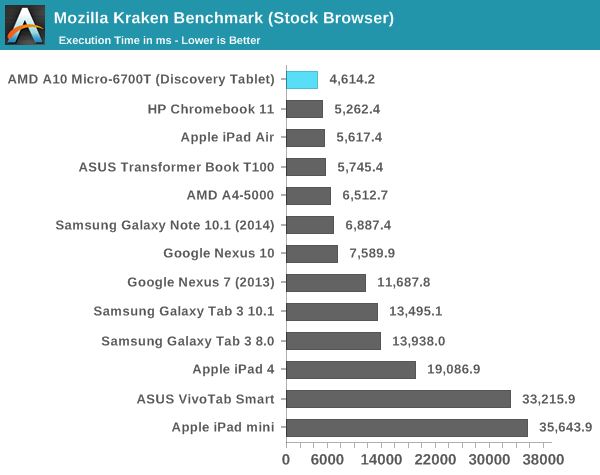

CPU Performance
For these next tests I turned to some of our more traditional Windows PC benchmarks. I looked at Cinebench 11.5 to get an idea for how single and multithreaded performance have changed since last year.
Looking at single threaded performance we immediately see the benefits of AMD's new boosting capabilities. The Puma+ cores are 35% faster than Intel's Silvermont cores, and can deliver nearly 80% of the performance of AMD's Piledriver cores found in Trinity. I threw some Llano results in here as well - Mullins offers around 85% of the performance of Llano.
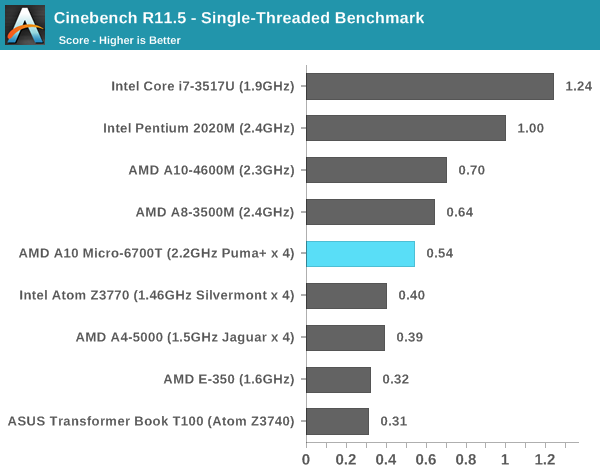
Multithreaded performance is pretty evenly matched between Bay Trail and Mullins here. Note that Mullins manages to deliver very similar performance to Kabini, despite coming in at substantially less power. The comparison to Brazos (E-350) is laughable, Mullins is substantially faster.
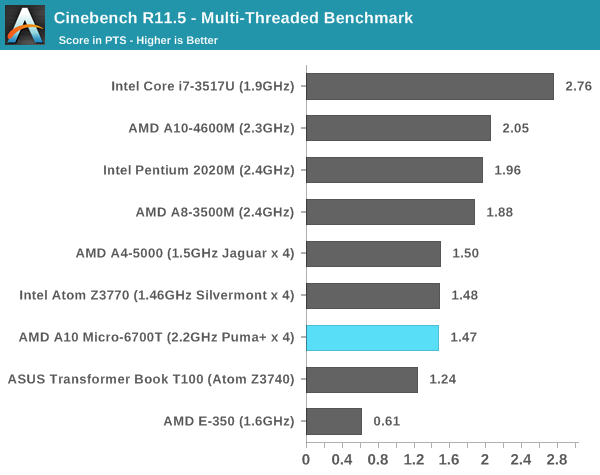
PCMark 7 gives us a better look at the overall performance of the Discovery tablet hardware. Here we do see it lose ground to the Kabini notebook (A4-5000) as well as the Bay Trail devices. It's unclear to me if we are seeing the thermal limits of the hardware (this is a longer test) or if there are other elements at work here (e.g. storage performance limits).
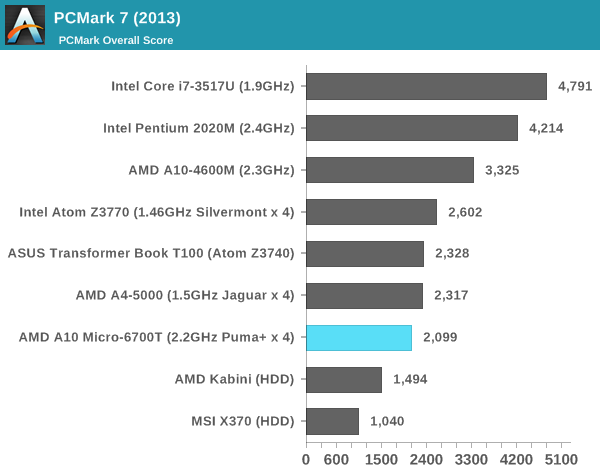
GPU Performance
We don’t actually have any Bay Trail devices in our Laptop 2013 bench, they are all in our Tablet 2013 category, which unfortunately uses different benchmarks. To make a long story short, we have Bay Trail vs. Kabini data, and Kabini vs. Mullins data. Thankfully the comparison between Bay Trail and Mullins is pretty easy to make.
AMD’s 4.5W TDP A10 Micro-6700T delivers roughly the same GPU performance as a 15W A4-5000. The A4-5000 also ends up being anywhere from 50% to over 2x the speed of Bay Trail when it comes to GPU performance, so you can expect Mullins to hold roughly the same advantage.
Compared to the old 35W Trinity, Mullins still has a ways to go. Trinity delivers roughly 2x the performance of Mullins, although at nearly 10x the TDP.
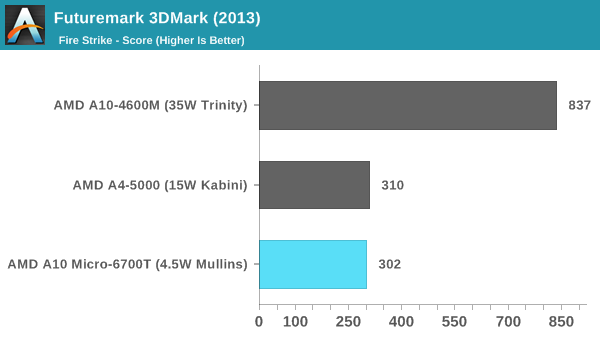
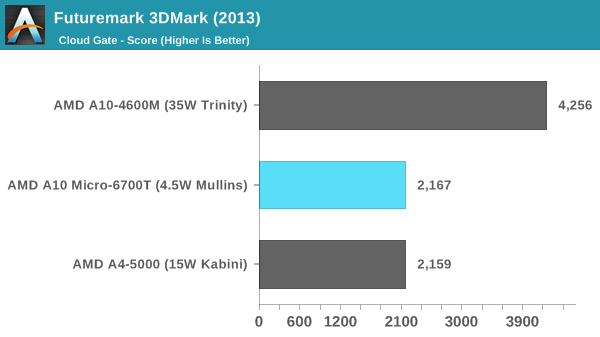
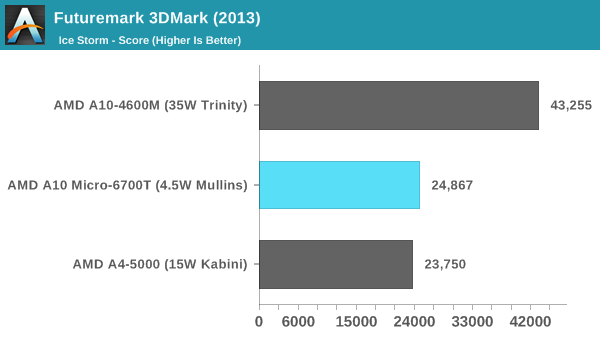


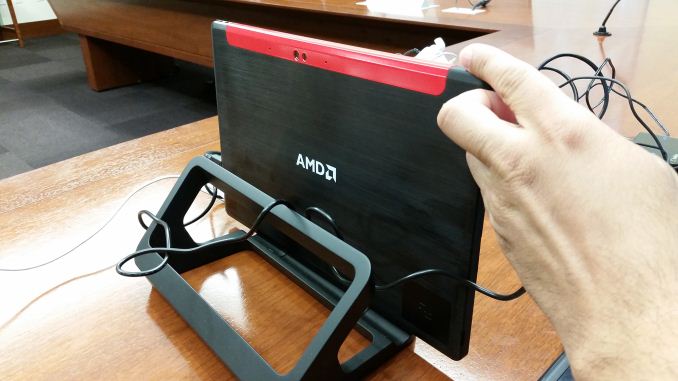
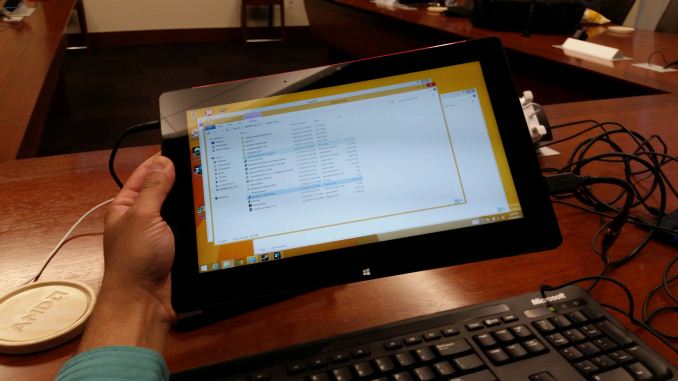














82 Comments
View All Comments
name99 - Tuesday, April 29, 2014 - link
"I’d expect a similar die size to Kabini/Temash. It’s interesting to note that these SoCs have a transistor count somewhere south of Apple’s A7."Isn't this something of an apple's to oranges comparison?
This AMD SOC is basically CPU+GPU+memory controller.
A7 is all that plus secure storage, ISP, h264 encoder/decoder (the genuine low power deal, not some "hardware assisted" frankenstein that runs the CPU and GPU [together, both at high power] to do the job) along with god knows what else --- flash controller? fingerprint recognition cell?
mczak - Tuesday, April 29, 2014 - link
Kabini / Temash also full custom hw video encode/decode (all gcn based chips do), though if you want some hybrid mode is still available, so that should be pretty comparable. Flash controller and the like, too. Yes no ISP, but OTOH there's quite a lot of stuff the A7 won't do too (like 2xsata, the 4x1 and 1x4 pcie 2.0 connectivity, 2xUSB 3.0, high-speed i/o isn't exactly cheap). Anyway, the transistor count and die size is comparable after all (based on the official numbers, Kabini is slightly larger, but the a7 has slightly more transistors, though there's both different methods to count transistors and measure die size, not to mention they come out of different fabs), and it shouldn't be a surprise.lmcd - Friday, May 2, 2014 - link
AMD should try partnering with Broadcom (as Broadcom has no real SoCs for smartphones).200380051 - Tuesday, April 29, 2014 - link
I am eager to see how Mantle-enabled games will perform on these Mullins tablets. It seems a good fit from a technical standpoint. It might just push the PC gaming sphere to dig into tablet space. This in turn directly expands the market of game studios.Also, I wonder if AMD's mobile lineup is to be the first product they'll roll out on Samsung's 14nm FINFET process. The process will be available starting 2015, as per their agreement. Its up to AMD to cook us a shrinked revision of these chips in a timely fashion.
Things are getting interesting.
MartinT - Wednesday, April 30, 2014 - link
It seems to me that performance numbers for these parts don't tell even half the story without the accompanying power readings, considering the 'use whatever power until the chassis burns the user' approach of AMD's turbo implementation.kirilmatt - Wednesday, April 30, 2014 - link
How AMD did this is amazing. Imagine if this was released instead of kabini/temash. This destroys Bay Trail. I only hope that it gets released soon so it doesn't have to compete with Intel's 14nm SoCs. Anyways, good job AMD!R3MF - Wednesday, April 30, 2014 - link
Ubuntu tablet please...purerice - Wednesday, April 30, 2014 - link
Would one way to test the "non-turbo" performance be to loop some test 100 times and see the performance decrease over time? Considering the turbo would decrease as the CPU/APU heats up we could see the performance difference and also how long you really get "turbo" turned on for.azazel1024 - Thursday, May 1, 2014 - link
I am impressed, but I am curious as to both why Bay Trail beats it in the PCMark testing by a fair margin, but not in individual CPU benchmarks. If that is thermal limits...well, I will say that a lot of tablet workloads are very short term. Windows tablet workloads (at least mine)...not so much.Enough of what I do would likely hit those thermal constraints and at least in my testing, my T100 doesn't clock down even under very prolonged workloads, like 15+ minutes of converting RAW to JPEG images. Or long gaming, like an hour or two of KSP.
That and I have concerns about that idle and low power use. Seems to be pretty good under higher load and performance seems to be there (with caveat/concern)...but idle and low power could be an issue. According to those AMD specs, the APU itself is using darn near 2w of power streaming 1080p. Based on my math, my T100 TOTAL uses around 2.4w of power when streaming 1080p (around 13hrs of run time, 31whr battery). I assume that the display, wifi, signal processor, memory, etc, etc are consuming more than .6w of power.
Having a much bigger battery or much shorter run time could be a big sticking point for a lot of tablet users (I know I'd have an issue if my 6-7hrs gaming/10hrs normal use/13hrs video turned in to more like 3hrs gaming/6hrs normal use/8hrs video.
FITCamaro - Wednesday, May 7, 2014 - link
My next tablet will likely be a Windows 8.1 tablet. I'd love the high end AMD CPU tested here even if it doesn't do as well on power as Baytrail but bests it in GPU performance. Would be nice to be able to do better light mobile gaming.